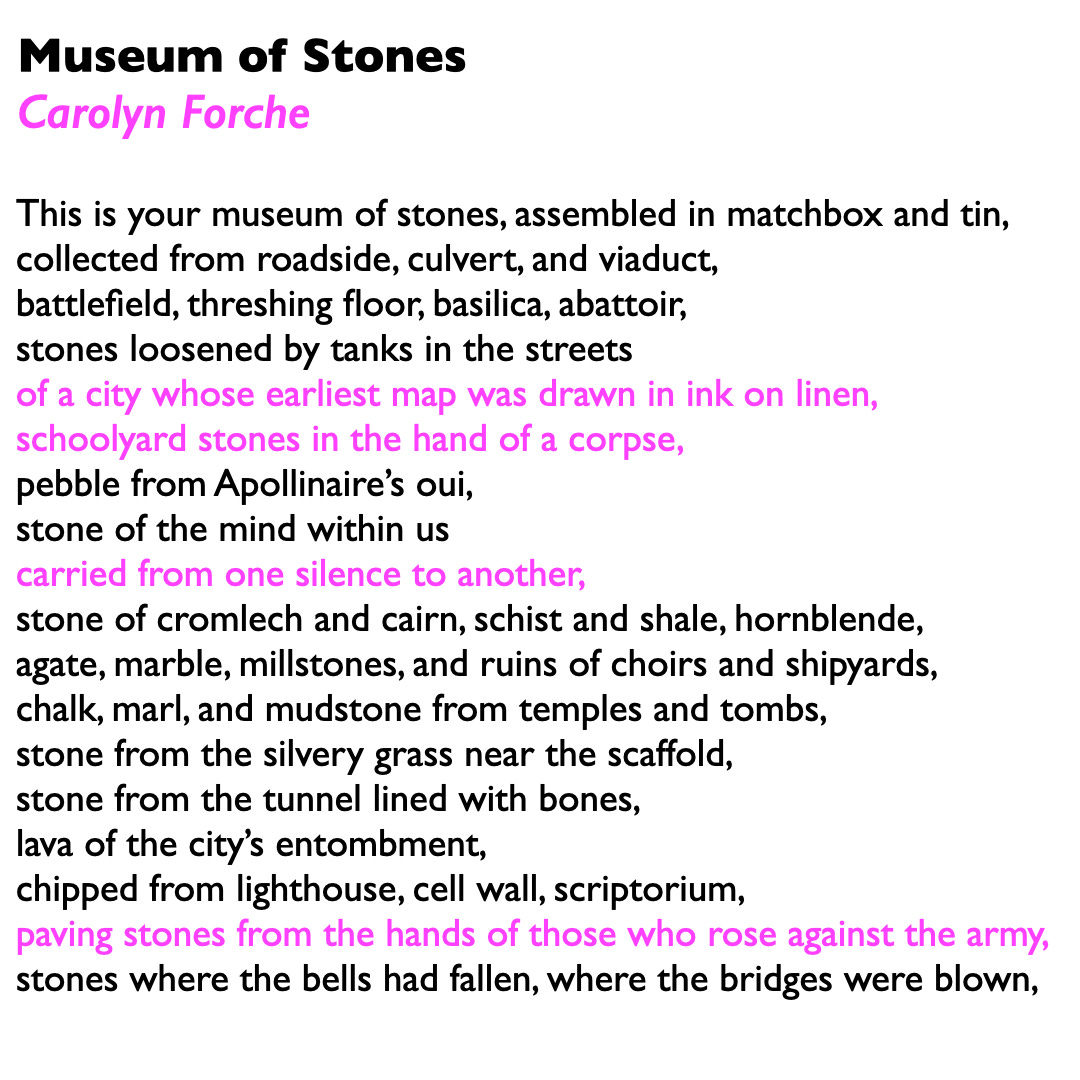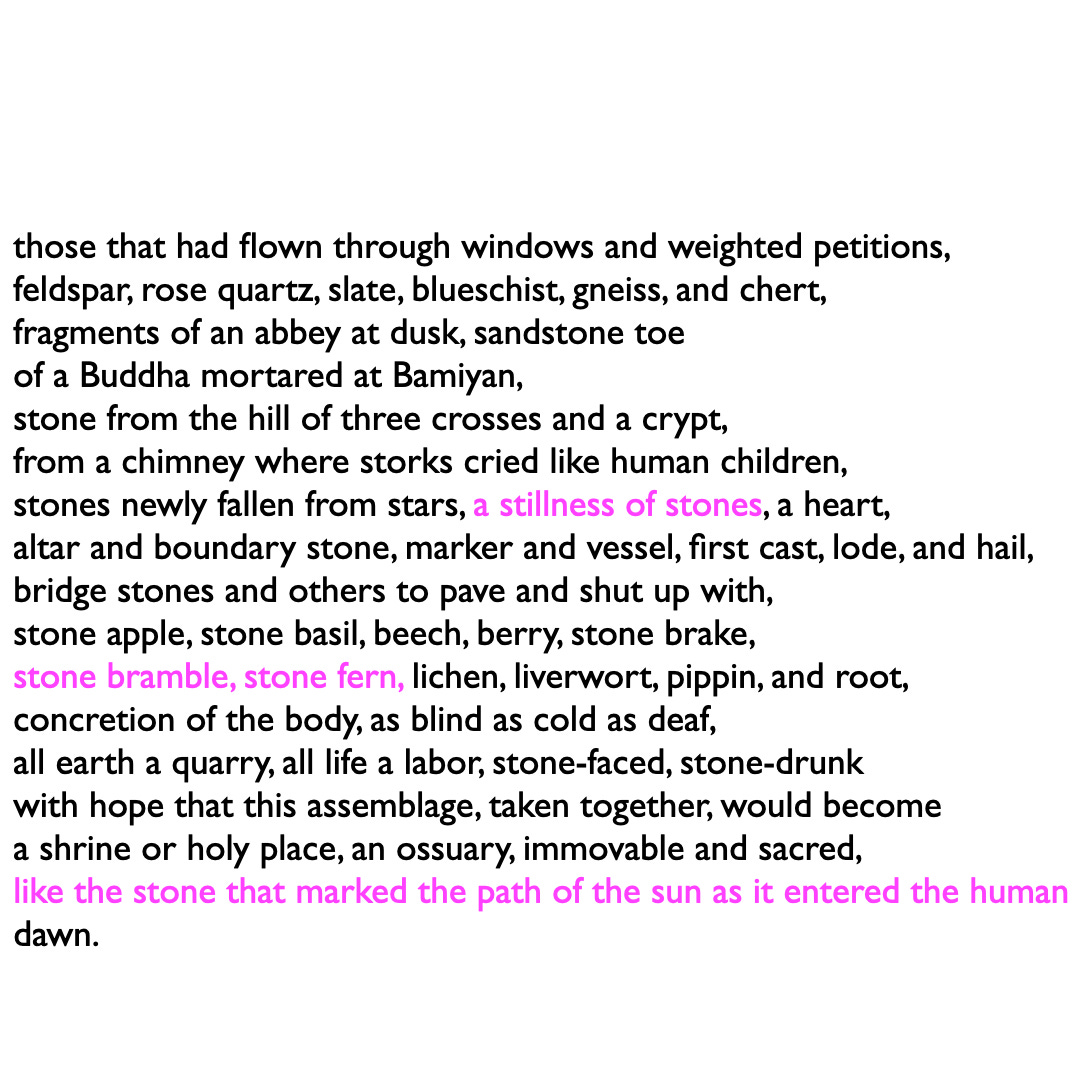The poetry of stones is testimony to the everydayness of the lyric form. It is an ode to attention, but also imagination’s spring. There is an impulse in the poetic that mimics the cinematic eye. I’m speaking here, specifically about the cut (in editing) as a kind of metonymic exercise. In several epic films for instance, set in earlier times, the first surge of blood that accompanies the onslaught, is encrusted with chain mail, and the visual panorama of great fighting hordes. It is not always the wide-angle lens that makes the establishing shot, however. In the sequential escalation of drama, there might be a montage of close ups of glinting armour on limbs and flanks. Chain Mail clatters noisily through various congested frames, and perhaps the camera would capture the sun ricocheting off naked metal. You do not see the circus of war, but you can feel it in the atmosphere that’s created with metonymy - a slow tracking shot of nothing but marching boots, and trailing swords, say. Then suddenly there is a cut, or a disproportionate zoom out, and we get to see the entire vista; layers of military rank synchronised to the stylised hollywood aesthetics of violence. Man and beast lick their lips in the performed anticipation of blood, and then the great war locker room pep talk - “Not today….” etc.
Consider the movement from the particular to the general, the concentrated to the dispersed. While the movement could be restricted to that particular setting, Imagine, dear reader, a montage of what is happening all over the world in that moment. In an inspired, but unsettling cut, the auteur takes us to a bazaar in Istanbul, and the sounds of the battlefield melt neatly into the buzz of commerce. But it doesn’t stop there - say that the loud bargaining and the sensorium of the cityscape makes way for the stillness of an alley in an Eliotesque central london, or the disquiet of Pessoa’s lisbon, where a hooded man stands waiting to mug the next unsuspecting passer-by, and you can smell the suspense. In a fictional universe, this activity could go on forever. One could ski across time and space, finding moments of commonplace historical significance.
The poem I share with you today uses this familiar poetic trope - turning the stone into a metaphor for the the politics of human destruction and creation. I have heard Carolyn Forche read this poem live in a virtual setting, during a workshop. I am grateful for this experience, because there is no feeling like hearing a poet read their own work. Talking of the ‘originary’ impulse of the poem- she mentioned that it was written for a friend who would collect stones from places that he went to. He would mark these little finds - his “museum of stones” would have an exhibit like “Pebble from the Eiffel Tower” with a timestamp that had the exact date of the visit.
Like the other poems from the collection that houses this one, the poet courts the ‘list’, the litany, the catalogue, or the inventory.
There is a story to the last two lines as well. Forche talked about how she liked every poem to take her to a place of new discovery (or else she would exile it). In the context of this poem, the last two lines actually refer to a place in Ireland - the passage tomb at Newgrange. This is a heritage site, and apparently, there is a particular time of day when you can see “the path of the sun” actually marked by a stone, and one can see the light make an entrance like some miraculous herald. Forche tells the story of this place, and how in the Stone age, children helped build this monument lugging huge stones from long distances to this spot. There are stones that mark astronomical events across the world. This was one of the organic ways that humans located themselves within the expanse of their lived universe in those days.
Today, among other things, we have compasses, and geolocation.
Ah well, I’m still searching…
Do make a detour to Carolyn Forche’s The Colonel. I have written briefly, and cited from her essay on “The Poetry of Witness” in that commentary, too. It is quite a touching story that she shares about a poetry reading that she did of that poem in Tripoli.
I hope you are doing well, and this winter is kind. If you like what you read, do consider ‘buying me a coffee’.
Note: Those, not in India, who’d like to support the work I do at Poetly, write to me - poetly@pm.me.
If you wanna share this post…




